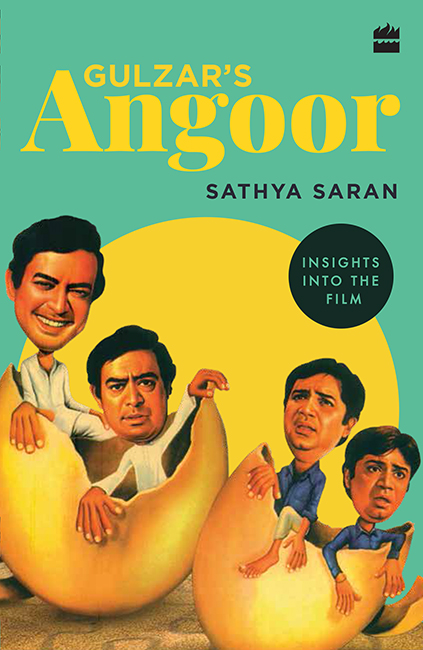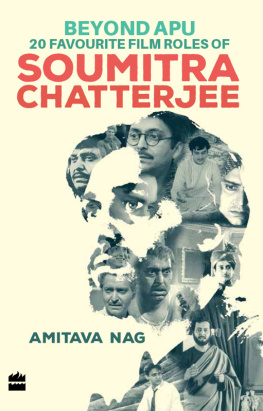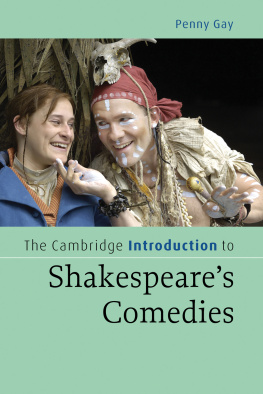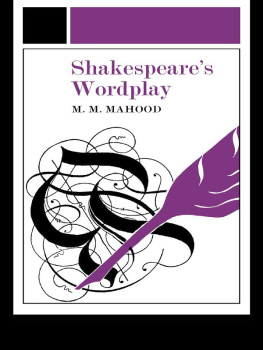Table of Contents
- 2. Gulzar Sees a Thriller
A Story - 5. Do Dooni Char
The Film that Wasnt - 6. The Comic Trail
Many Kinds of Laughter - 9. Angoor
A Sweet Sour Story - 12. The Song as Comedy
Jest Music - 13. Angoor
The Film - 14. Dialogue as Comedy
A Smile in Every Line


To a Bard who set the ball rolling.
And a poet who picked it up and changed it into
a bunch of grapes!
Contents

2 | Gulzar Sees a Thriller
A Story
5 | Do Dooni Char
The Film that Wasnt
6 | The Comic Trail
Many Kinds of Laughter
9 | Angoor
A Sweet Sour Story
12 | The Song as Comedy
Jest Music
13 | Angoor
The Film
14 | Dialogue as Comedy
A Smile in Every Line

Ask me to choose between a comedy and a tragedy, and I will go straight for the latter. Tragedies are thought-provoking; they delve into human nature, the failings and foibles of great and small people. Tragedies show us our weaknesses and warn us of the pitfalls that await even those who have achieved greatness. Comedies, on the other hand, make us laugh, sweep us into a long moment of forgetfulness, delivering an opiate for the senses from the travails of daily living. And when they are done, the reality is twice as hard. Tragedies, on the other hand, make you realize that indeed all the world is a stage, and your problems are small compared to what befell those on screen or stage. They also give you insights into how relationships develop, change, turn sour, and oh come on, tragedies teach a lot. Comedies, well, as I said before, they just make you laugh.
Which is why when, of the three books chosen to present Gulzars cinema, I was presented with Angoor, I baulked a little. I was thrilled to be working on a book on Gulzars film, being one among his legion of fans, but Angoor hmm. I had watched the film, it was funny, I remembered. But really, I would have preferred Ijaazat. So nuanced a film, such a compelling story, such music, and then there was the visual poetry that added to the actors craft. Yes, if given a choice, Ijaazat it would have been.
But the die had been cast, and Angoor it was. I took the assignment and carried it off like a prize, a consolation prize, but still, one I was happy to have been awarded.
Watching the film at home, I realized that what I thought was gilt was indeed gold. Here was comedy that was not just a series of funny moments strung together. Here was one master artist working on the material created by the master of all craftsmen, Shakespeare, and making it all his own. When the film ended, I sat back, leaned forward and started it all over again, realizing by now, that there were so many layers in the film that needed attention. Suddenly, comedy held a new meaning. I took a deep breath and prepared to take the full measure of what I had on hand.
Everything about Angoor is worth paying attention to. Almost every gesture, every line of dialogue or song has a reason for being. It is tightly knit, unlike most comedies, except for a few exceptions, which, in my mind primarily include Chalti ka Naam Gaadi, Jaane Bhi Do Yaaro, Chupke Chupke, and Gol Maal. Incidentally, the last two are also written by Gulzar.
Angoor kept me quite busy. A major handicap was that Sanjeev Kumar was no longer around, and Deven Verma was too ill to give me audience when I called, and passed away before I could ask again. Moushumi Chatterjee would only speak to me on the phone, and her information was sketchy at best. It remained for Deepti Naval and Gulzar to fill in the main actors parts too, and give me enough about their approach to their roles. Happily for me, both filled the need most adequately. Besides, insights from director Debu Sen and actress Tanuja helped shed light on the behind-the-scenes action in Do Dooni Char.
Shantanu Ray Chaudhuri, who was my editor when I started the book, gave me the idea of also delineating the history of comedy in Hindi cinema to be able to give Angoor a proper setting. That chapter, I think will also help readers understand the highly evolved humour of Angoor, that has the capacity to entertain anyone from eight-year-olds onwards. In fact, at every decade of his life, the viewer will discover new meanings to the lines.
Writing the book has been fun. It took me back to my student days when as a student of literature I had to take apart a book, a play or some piece of writing to understand it, critique it and present it so others would get the most of the original, thanks to my interpretation.
So, dear reader, that is what this book tries to do. To unravel the craft of the writer, demystify the craft of the filmmaker, present the value of enjoyment that the lyrics and music add, all of which when combined by the actors genius in comic timing, makes for great viewing. My challenge was to keep it light and fun, and not make the book into a dissertation. I think I have managed that!
A good script lies at the heart of every good film. Writing comedy is so much tougher than writing tragedy. Tragedy presents itself at every turn. Comedy hides in secret places, and only the sharpest eye and keenest mind can discover and reveal it. Thanks to Angoor, I know this.
If after reading this book, you decide to watch Angoor again, I know I have risen to the task. Be sure you sit around with the entire family to watch the film. It is a great bonding device!

It all began with Shakespeare.
Of course there are many versions of the possible dates and chronology of Shakespeares plays. But the Encylopedia Britannica states that his much loved comedy, The Comedy of Errors, was the Bards fourth creation, coming on the heels of The Two Gentlemen of Verona, Loves Labour Lost, and Henry VI Part One and, TitusAndronicus. Critics were of course still watching the new playwright closely, and found it fit to label the play an apprentice comedy. Despite the criticism, Shakespeare put up the play on the Feast of the Holy Innocents, on 28 December 1594, at the Grays Inn Christmas Revels to a learned audience of lawyers and aspirants to the legal profession, who found it entertaining despite the slapstick elements, that were quite a departure from the playwrights earlier works. In fact, the play contributed to the rowdy Christmas celebrations, as recorded in the Gesta Grayorum published in 1688. Established as a play perfect for Christmas revels, it was performed again at Court in 1604, when The Plaie of Errors, by Shaxberd was staged by His Majestys Players.
As anyone who has studied Shakespeare knows, most of his stories were based on either an older, classical tale, or were an amalgamation of many such stories. This would be true in the case of his most famous plays like Hamlet, Prince of Denmark and Macbeth, and was true too of The Comedy of Errors, which is reportedly based on Menaechmi, a Roman comedy written by the ancient dramatist Plautus who lived between 254184 BC, which Shakespeare read as an English translation in the late 1590s.









